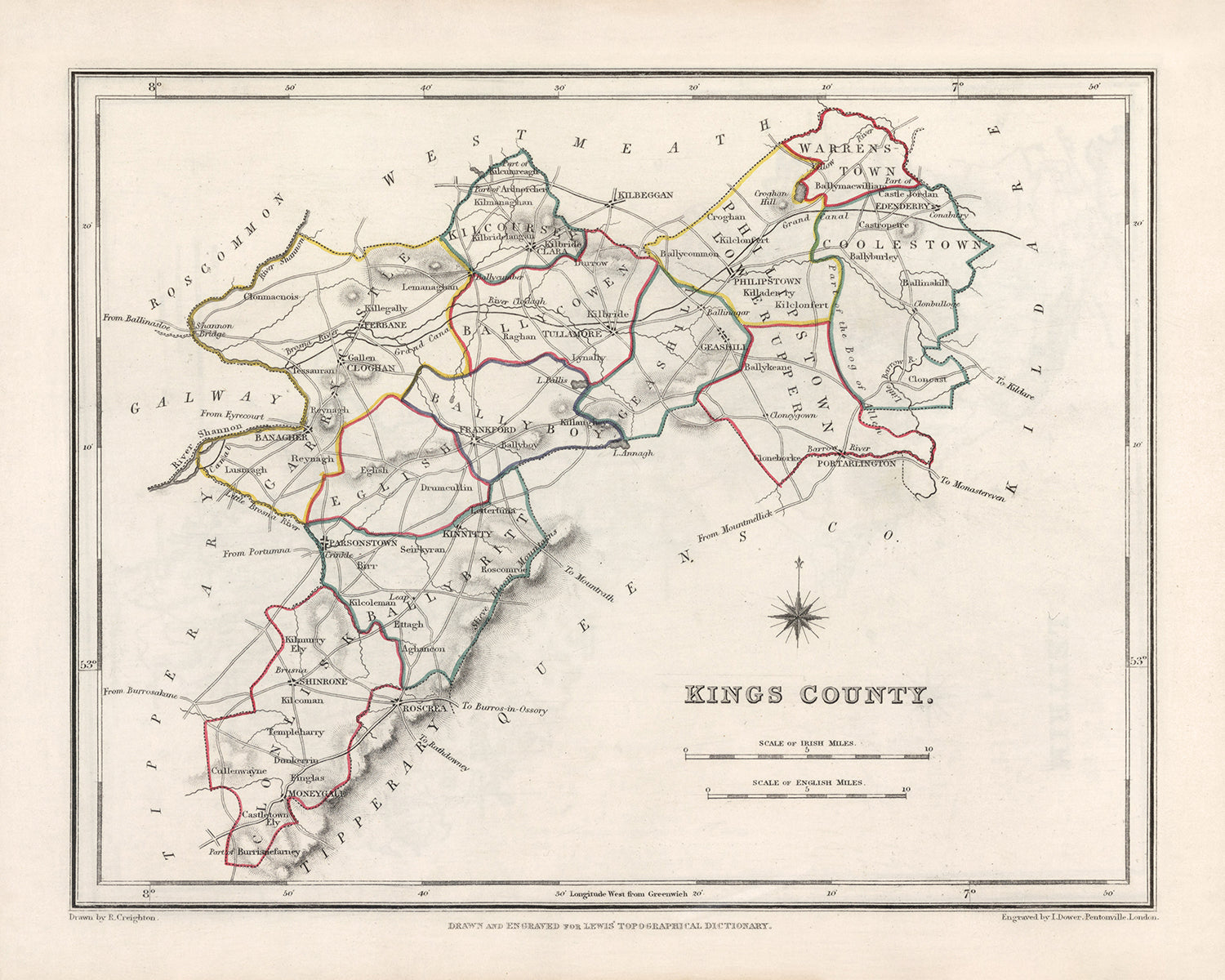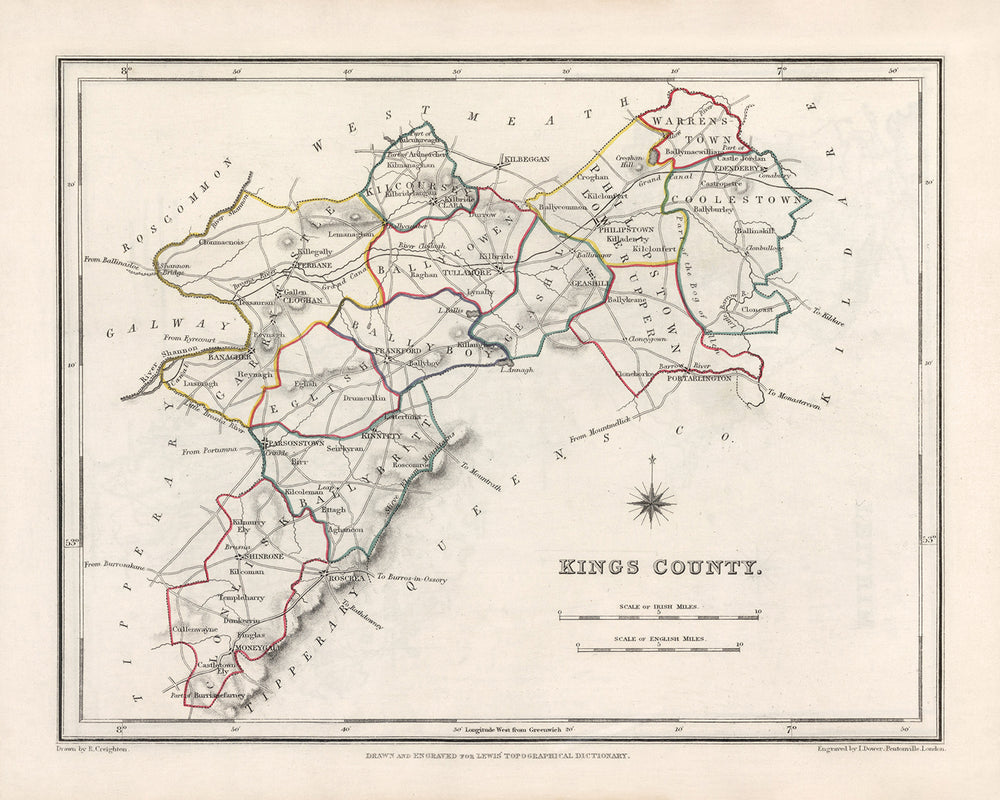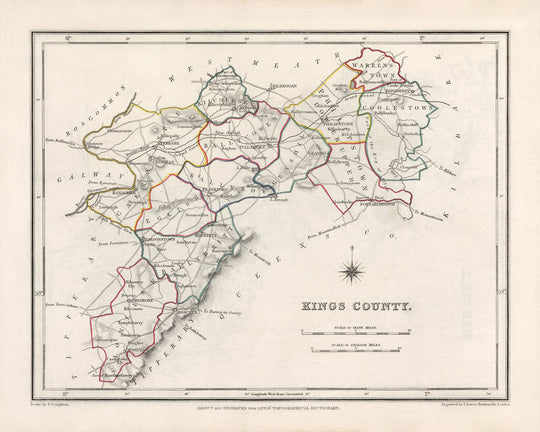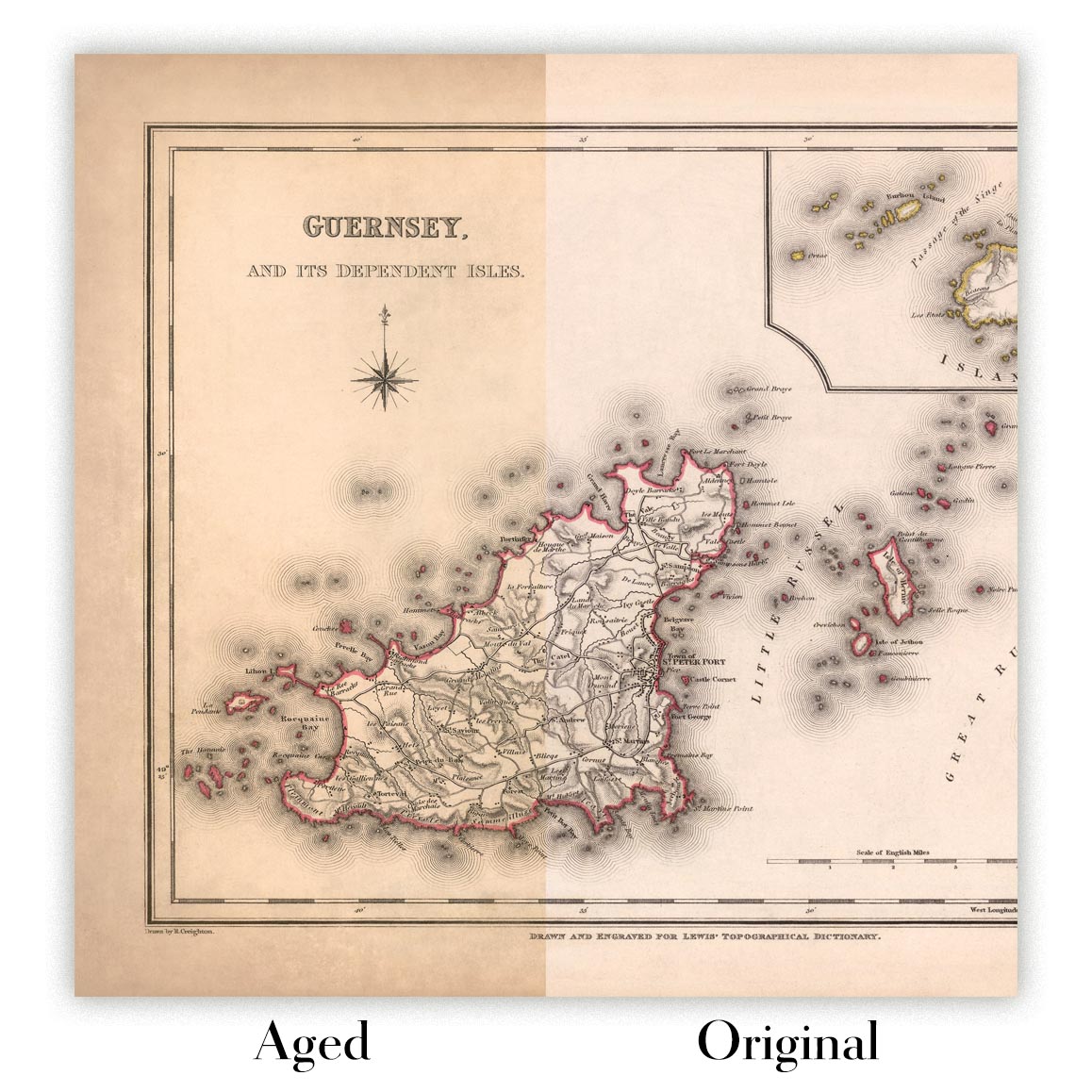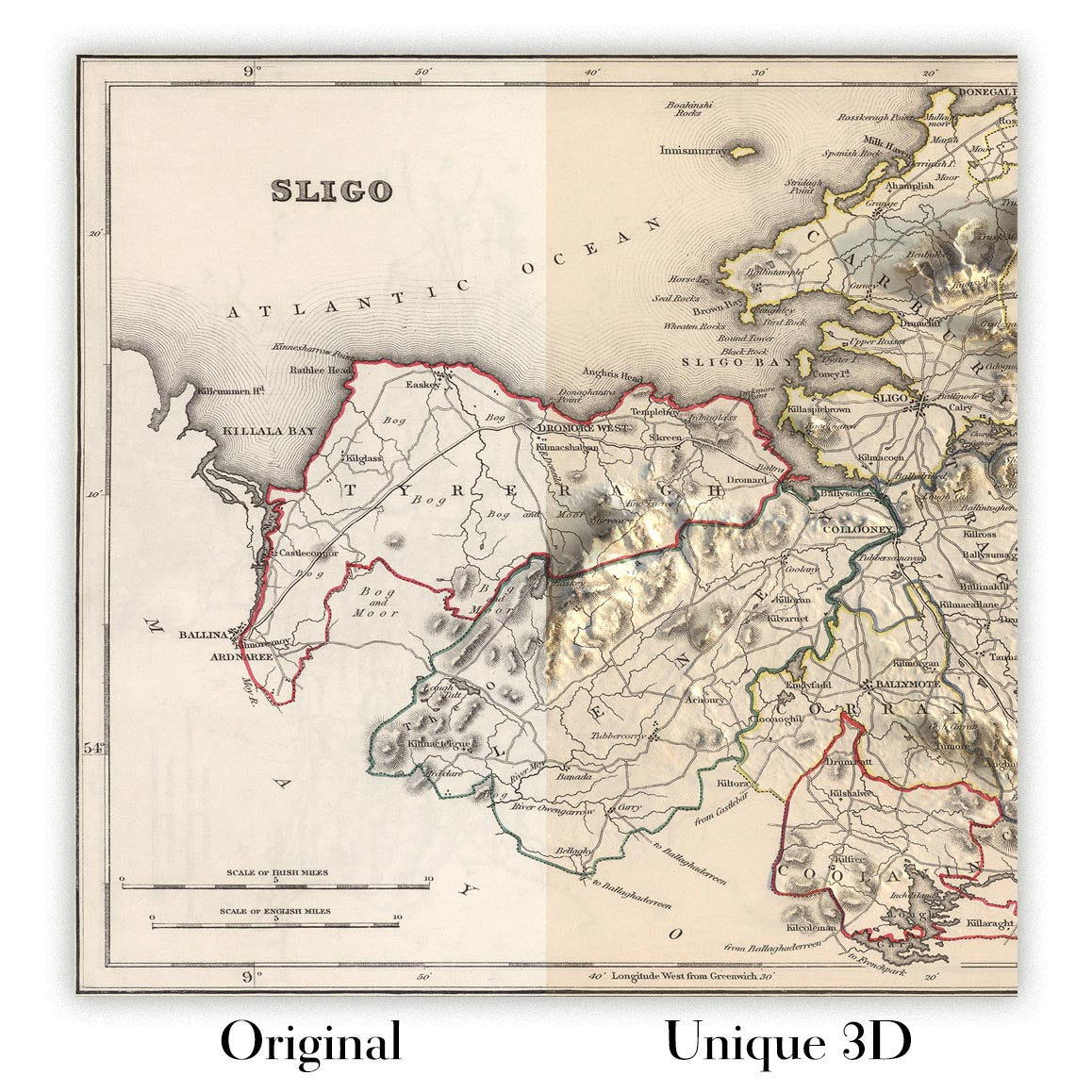- Handmade locally. No import duty or tax
- FREE Delivery by Christmas
- Love it or your money back (90 days)
- Questions? WhatsApp me any time
Own a piece of history
5,000+ 5 star reviews


This Old Map of Offaly (King's) by Samuel Lewis in 1844 is a captivating piece that offers a glimpse into the historical landscape of County Offaly, Ireland. With its intricate details and exquisite craftsmanship, this map is a true collector's item for history enthusiasts and cartography aficionados alike.
Featuring the main towns, cities, and other interesting features of County Offaly (King's), this map showcases the rich heritage and notable landmarks of the region. While some modern cities may not be depicted on this map, it provides an exciting opportunity to explore earlier names and discover how the landscape has evolved over time.
Notable settlements and colonies founded before 1840 within the historical boundaries of County Offaly (King's) include:
- Tullamore (c. 1571): Known for its grand Tullamore Dew Distillery and the historic Charleville Castle, Tullamore is a town steeped in history and charm.
- Birr (c. 1620): Home to the magnificent Birr Castle and its world-renowned Great Telescope, Birr is a town renowned for its scientific and architectural achievements.
- Banagher (c. 1609): Situated on the banks of the River Shannon, Banagher boasts a rich maritime history and offers stunning views of the river.
- Clara (c. 1620): Clara is a vibrant town that was once a hub of industry, particularly known for its thriving textile mills.
- Edenderry (c. 1770): Nestled in the heart of Offaly, Edenderry is a town with a strong agricultural heritage and a rich tapestry of historical sites.
The list of notable settlements and colonies founded before 1840 continues with:
- Shinrone (c. 1600): A picturesque village known for its charming thatched cottages and historic St. Mary's Church.
- Rhode (c. 1609): Famous for its ancient monastic site and the impressive Rhode Castle, this village is a testament to Ireland's medieval past.
- Ferbane (c. 1620): Once a bustling market town, Ferbane is home to the striking Clonmacnoise Monastic Site, a significant archaeological and religious site.
- Ballycumber (c. 1620): Surrounded by rolling countryside, Ballycumber is a tranquil village with a rich agricultural heritage.
- Shannonbridge (c. 1620): Located on the banks of the River Shannon, Shannonbridge offers a glimpse into Ireland's waterway history and features the iconic Clonmacnoise Bridge.
- Kilcormac (c. 1620): Kilcormac is a charming village with a strong sense of community and a rich history dating back centuries.
- Daingean (c. 1620): Formerly known as Philipstown, Daingean is a picturesque village with a fascinating history and a scenic location along the Grand Canal.
- Kinnitty (c. 1620): Nestled at the foothills of the Slieve Bloom Mountains, Kinnitty is renowned for its stunning landscapes and the enchanting Kinnitty Castle.
- Cloghan (c. 1620): Surrounded by beautiful countryside, Cloghan is a small village with a close-knit community and a rich agricultural heritage.
- Shannon Harbour (c. 1620): Situated on the Grand Canal, Shannon Harbour is a picturesque village known for its tranquil waterways and scenic beauty.
- Durrow (c. 1620): Durrow is a charming village with a rich history and is home to the impressive Durrow Abbey and High Cross.
- Clonbullogue (c. 1620): Clonbullogue is a quaint village with a strong aviation history, known for its glider activity and the nearby Irish Parachute Club.
- Clonony (c. 1620): This village is home to the remarkable Clonony Castle, a beautifully preserved Tudor mansion that offers a glimpse into Ireland's architectural heritage.
- Rahan (c. 1620): Rahan is renowned for its ancient monastic site, which features the impressive Rahan Early Christian Church and Round Tower.
- Kilbeggan (c. 1620): Kilbeggan is a historic town known for its world-famous Kilbeggan Distillery, one of the oldest licensed distilleries in the world.
- Belmont (c. 1620): Surrounded by lush greenery, Belmont is a tranquil village with a rich agricultural history and a strong sense of community.
- Mountbolus (c. 1620): Mountbolus is a picturesque village with a close-knit community and a scenic location in the heart of Offaly.
- Clonmacnoise (c. 545): A renowned monastic site and an important center of religion and learning in medieval Ireland, Clonmacnoise is a must-visit historical attraction.
- Ballyboy (c. 1620): Ballyboy is a charming village with a rich agricultural heritage and a tranquil atmosphere.
- Tubber (c. 1620): Nestled in the Slieve Bloom Mountains, Tubber is a picturesque village known for its stunning natural surroundings and scenic beauty.
- Ballinagar (c. 1620): Ballinagar is a quaint village with a strong sense of community and a rich agricultural history.
- Geashill (c. 1620): Home to the striking Geashill Castle, this village offers a glimpse into Ireland's architectural heritage and historic past.
- Pollagh (c. 1620): Surrounded by beautiful countryside, Pollagh is a small village with a rich agricultural history and a close-knit community.
- Broughal (c. 1620): Broughal is a charming village with a tranquil atmosphere and a strong sense of community.
- Killeigh (c. 1620): Killeigh is a picturesque village known for its scenic beauty and historic sites, including the impressive Killeigh Castle.
- Bracknagh (c. 1620): Bracknagh is a quaint village with a rich agricultural heritage and a close-knit community.
- Cadamstown (c. 1620): Nestled in the Slieve Bloom Mountains, Cadamstown is a picturesque village renowned for its stunning natural surroundings and outdoor activities.
Notable boundaries, rivers, canyons, national parks, and natural phenomena in County Offaly (King's), Ireland include the River Shannon, Slieve Bloom Mountains, and the Grand Canal.
Between 1800 and 1850, County Offaly (King's) witnessed several significant historical events, including the Irish Rebellion of 1803 led by Robert Emmet and the Great Famine that struck Ireland from 1845 to 1852, resulting in widespread devastation and mass emigration.
Own a piece of history with this Old Map of Offaly (King's) by Samuel Lewis in 1844. Immerse yourself in the rich heritage and captivating beauty of County Offaly (King's), Ireland, as you explore the towns, cities, and historical landmarks that shaped this remarkable region.
Please double check the images to make sure that a specific town or place is shown on this map. You can also get in touch and ask us to check the map for you.
This map looks great at all sizes: 12x16in (30.5x41cm), 16x20in (40.5x51cm), 18x24in (45.5x61cm), 24x30in (61x76cm), 32x40in (81.5x102cm) and 40x50in (102x127cm), but it looks even better when printed large.
I can create beautiful, large prints of this map up to 50in (127cm). Please get in touch if you're looking for larger, customised or different framing options.
The model in the listing images is holding the 16x20in (40.5x51cm) version of this map.
The fifth listing image shows an example of my map personalisation service.
If you’re looking for something slightly different, check out my main collection of UK and Ireland maps.
Please contact me to check if a certain location, landmark or feature is shown on this map.
This would make a wonderful birthday, Christmas, Father's Day, work leaving, anniversary or housewarming gift for someone from the areas covered by this map.
This map is available as a giclée print on acid free archival matte paper, or you can buy it framed. The frame is a nice, simple black frame that suits most aesthetics. Please get in touch if you'd like a different frame colour or material. My frames are glazed with super-clear museum-grade acrylic (perspex/acrylite), which is significantly less reflective than glass, safer, and will always arrive in perfect condition.
This map is also available as a float framed canvas, sometimes known as a shadow gap framed canvas or canvas floater. The map is printed on artist's cotton canvas and then stretched over a handmade box frame. We then "float" the canvas inside a wooden frame, which is available in a range of colours (black, dark brown, oak, antique gold and white). This is a wonderful way to present a map without glazing in front. See some examples of float framed canvas maps and explore the differences between my different finishes.
For something truly unique, this map is also available in "Unique 3D", our trademarked process that dramatically transforms the map so that it has a wonderful sense of depth. We combine the original map with detailed topography and elevation data, so that mountains and the terrain really "pop". For more info and examples of 3D maps, check my Unique 3D page.
For most orders, delivery time is about 3 working days. Personalised and customised products take longer, as I have to do the personalisation and send it to you for approval, which usually takes 1 or 2 days.
Please note that very large framed orders usually take longer to make and deliver.
If you need your order to arrive by a certain date, please contact me before you order so that we can find the best way of making sure you get your order in time.
I print and frame maps and artwork in 23 countries around the world. This means your order will be made locally, which cuts down on delivery time and ensures that it won't be damaged during delivery. You'll never pay customs or import duty, and we'll put less CO2 into the air.
All of my maps and art prints are well packaged and sent in a rugged tube if unframed, or surrounded by foam if framed.
I try to send out all orders within 1 or 2 days of receiving your order, though some products (like face masks, mugs and tote bags) can take longer to make.
If you select Express Delivery at checkout your order we will prioritise your order and send it out by 1-day courier (Fedex, DHL, UPS, Parcelforce).
Next Day delivery is also available in some countries (US, UK, Singapore, UAE) but please try to order early in the day so that we can get it sent out on time.
My standard frame is a gallery style black ash hardwood frame. It is simple and quite modern looking. My standard frame is around 20mm (0.8in) wide.
I use super-clear acrylic (perspex/acrylite) for the frame glass. It's lighter and safer than glass - and it looks better, as the reflectivity is lower.
Six standard frame colours are available for free (black, dark brown, dark grey, oak, white and antique gold). Custom framing and mounting/matting is available if you're looking for something else.
Most maps, art and illustrations are also available as a framed canvas. We use matte (not shiny) cotton canvas, stretch it over a sustainably sourced box wood frame, and then 'float' the piece within a wood frame. The end result is quite beautiful, and there's no glazing to get in the way.
All frames are provided "ready to hang", with either a string or brackets on the back. Very large frames will have heavy duty hanging plates and/or a mounting baton. If you have any questions, please get in touch.
See some examples of my framed maps and framed canvas maps.
Alternatively, I can also supply old maps and artwork on canvas, foam board, cotton rag and other materials.
If you want to frame your map or artwork yourself, please read my size guide first.
My maps are extremely high quality reproductions of original maps.
I source original, rare maps from libraries, auction houses and private collections around the world, restore them at my London workshop, and then use specialist giclée inks and printers to create beautiful maps that look even better than the original.
My maps are printed on acid-free archival matte (not glossy) paper that feels very high quality and almost like card. In technical terms the paper weight/thickness is 10mil/200gsm. It's perfect for framing.
I print with Epson ultrachrome giclée UV fade resistant pigment inks - some of the best inks you can find.
I can also make maps on canvas, cotton rag and other exotic materials.
Learn more about The Unique Maps Co.
Map personalisation
If you're looking for the perfect anniversary or housewarming gift, I can personalise your map to make it truly unique. For example, I can add a short message, or highlight an important location, or add your family's coat of arms.
The options are almost infinite. Please see my map personalisation page for some wonderful examples of what's possible.
To order a personalised map, select "personalise your map" before adding it to your basket.
Get in touch if you're looking for more complex customisations and personalisations.
Map ageing
I have been asked hundreds of times over the years by customers if they could buy a map that looks even older.
Well, now you can, by selecting Aged before you add a map to your basket.
All the product photos you see on this page show the map in its Original form. This is what the map looks like today.
If you select Aged, I will age your map by hand, using a special and unique process developed through years of studying old maps, talking to researchers to understand the chemistry of aging paper, and of course... lots of practice!
If you're unsure, stick to the Original colour of the map. If you want something a bit darker and older looking, go for Aged.
If you are not happy with your order for any reason, contact me and I'll get it fixed ASAP, free of charge. Please see my returns and refund policy for more information.
I am very confident you will like your restored map or art print. I have been doing this since 1984. I'm a 5-star Etsy seller. I have sold tens of thousands of maps and art prints and have over 5,000 real 5-star reviews. My work has been featured in interior design magazines, on the BBC, and on the walls of dozens of 5-star hotels.
I use a unique process to restore maps and artwork that is massively time consuming and labour intensive. Hunting down the original maps and illustrations can take months. I use state of the art and eye-wateringly expensive technology to scan and restore them. As a result, I guarantee my maps and art prints are a cut above the rest. I stand by my products and will always make sure you're 100% happy with what you receive.
Almost all of my maps and art prints look amazing at large sizes (200cm, 6.5ft+) and I can frame and deliver them to you as well, via special oversized courier. Contact me to discuss your specific needs.
Or try searching for something!







